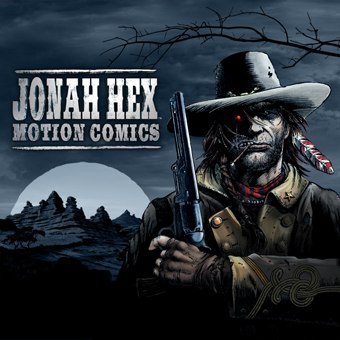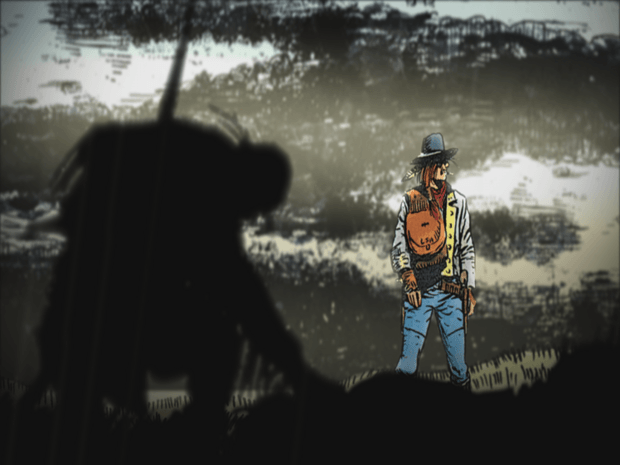Ian Kirby explains how Sequence made Jonah Hex jump off the page in its Motion Comics series.
Check out the Jonah HexMotion Comic clip at AWNtv!
Motion Comics have come a long way since Vancouver-based Sequence Post (www.thesequencegroup.com) started the format with Broken Saints back in 2001. That was when Ian Kirby worked with two friends in a basement using only Flash. Unable to create fully animated content on their budget (they couldn't afford voice actors), Sequence has nonetheless paved the way in making Motion Comics an immersive experience with such works as Batman: Black & White Motion Comics.
However, Jonah Hex, Warner Premiere's eighth Motion Comic series, is the perfect jump off the page vehicle for the award-winning Sequence. Old West style greed, lust and the supernatural are a natural when matched with the scarred, ruthless bounty hunter with a conscience. Based on the comic book written by John Albano, drawn by artist Tony DeZuniga and published by DC Comics, Jonah Hex Motion Comics are now available on the iTunes Store (http://click.linksynergy.com/fs-bin/click?id=If/6vWDVyVQ&offerid=146261.10005726&type=3&subid=0&u1=JonahHexMotionComics_GeekChic_ExternalPortal_042810) (www.itunes.com) and other online digital distributors (http://amzn.to/abP64X). The Jonah Hex Motion Comic also inspired the upcoming June 18 feature from Warner Bros. Pictures and Legendary Pictures.
Voiced by Jim Cummings, the first five episodes are adapted from the graphic novel Two Gun Mojo, in which the bounty hunter seeks justice and revenge against Doc Williams and his gang when a friend is murdered. The Gunfighter and The Hangin' Woman are two additional stories from the '70s comic series, re-colored and animated for the first time.
I spoke to Jonah Hex producer, director and Sequence owner Kirby about the challenges of creating the cutting edge Motion Comic.
Bill Desowitz: How did you approach Jonah Hex?
Ian Kirby:
The Jonah Hex universe offered a lot of artistic potential. His character is so strong and raw. When we got the scans from DC and Warner, the pages -- especially the Two Gun Mojo -- are really old material. We had to realign the plate but we know how to do this: our artists spend a lot of time cleaning, redrawing and stylizing. Our main focus was to maintain the authenticity of the original artwork. We wanted to take it to another level and bring it to a younger generation that might not pick up the old comic book. Depth was the biggest challenge. Will it play well in motion and on a big screen? What is the shot supposed to convey and we'll bring the viewers' focus on that with depth of field and any lighting stylization we might add to the shot. It's interesting how the Motion Comic process can work around different art styles and still create an immersive environment. We were true to the comic for the blood and the guts and the action of Jonah Hex: he's a dark character but he's a good guy. Bringing it to life could be almost be more work than animating from scratch -- all the pieces we had to cut up and redraw.
BD: What accounts for the huge jump in quality?
IK:
The quality of work based on tools. We deliver fully high-end HDCAM SR masters, which you could almost play theatrically.
BD: What other software do you use?
IK:
We used After Effects and Cinema 4D. Jonah Hex is a really good example of why we use After Effects. If you do a side-by-side comparison of what the panel originally looked like and what it looks like in the animation, we do a lot with depth of field, stylization and particle additions. We want to respect the original artwork, so we can't go in a full-run cycle: it's not full animation. And so the feeling that we want to get comes through the stylization of the piece. It's great to use After Effects because you have a lot of control over your stylization. The artist needs to have a strong animation background, but also a strong stylization background. How can we vignette this? How can we pull the viewer's attention to a certain moment to make this read as fully animated as possible?
With Cinema 4D, what we'll do is project a 3D texture onto a scene. There's a moment when Doc Williams is digging up a grave and it's texture-projected on: we'll do the grave, we'll do the tombstone and it keeps the painterly feel by doing a camera matte projection. Just like they do in a feature film for a matte painting background, we do the same for a lot of Motion Comic work.
BD: What's the process like?
IK: In a perfect world, we record all the dialogue first -- that really sets the pace for our work. Depending on the writers, sometimes the comic books are very heavy on narration and inner thoughts, which don't always play well. Sometimes we have to edit for time. We'll do camera moves in the Avid; reformat the panels for a widescreen environment. That's exported so our artists can start breaking it down, redrawing characters. They save a Photoshop file, which has different layering for hair, backgrounds, arms. They have a tight turnaround and break the shots down in two or three hours. We have the frame lengths entered in and the artists will start doing their first pass at animation. The animation for each frame is done in about two to three hours and maybe an hour for revisions. Scenes will be stylized, such as making a sunset play well. What glows are we using? What particles are we using to create a nice foggy environment? Certain epic shots will take six hours. We'll cut in the Avid and do reviews. Add then add sound design and music.
BD: Where do you see Motion Comics going? 3-D?
IK:
3-D is a definite possibility in the future. It's the fine balance of how far you go with the animation and then break out of the motion comic world. The amount of work that goes into Jonah Hex and some of their other projects, the line is really blurring. As soon as you get the lip flaps going, you're in full animation. But do you add a run cycle? Yeah, we are doing that in some of our upcoming projects. And it's basically turning into full animation from a printed comic.
Bill Desowitz is senior editor of AWN & VFXWorld.









